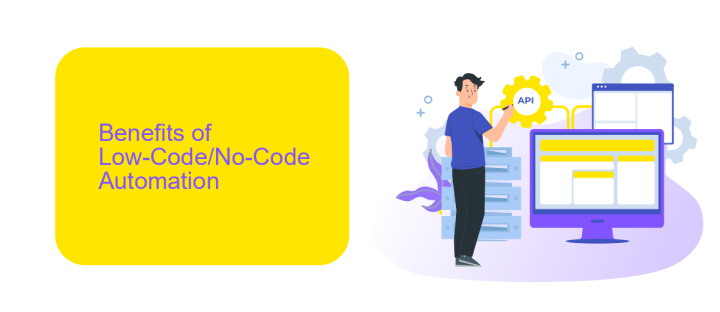Low-Code No-Code Automation
Low-code and no-code automation are revolutionizing the way businesses approach software development and process optimization. These innovative platforms empower users with little to no programming experience to create sophisticated applications and automate workflows quickly and efficiently. By democratizing technology, low-code and no-code solutions enable organizations to accelerate digital transformation, reduce costs, and foster a culture of innovation.
Introduction
The rise of Low-Code No-Code Automation has revolutionized the way businesses operate, enabling even non-technical users to create and manage complex workflows with ease. This paradigm shift has democratized software development, allowing organizations to innovate faster and more efficiently.
- Streamlined workflow automation
- Reduced dependency on IT departments
- Faster time to market
- Cost-effective solutions
One prominent tool in this space is ApiX-Drive, which facilitates seamless integration between various applications and services without the need for extensive coding. By leveraging such platforms, businesses can automate repetitive tasks, enhance productivity, and focus on strategic initiatives. The future of automation lies in empowering users with intuitive tools that simplify complex processes, driving innovation and growth.
Benefits of Low-Code/No-Code Automation

Low-code/no-code automation offers numerous benefits, significantly enhancing productivity and efficiency. By enabling users to create applications and automate workflows without extensive coding knowledge, it democratizes the development process. This empowers business users and non-technical staff to take control of their automation needs, reducing reliance on IT departments and accelerating project timelines. Moreover, the intuitive drag-and-drop interfaces and pre-built templates streamline the development process, allowing for rapid prototyping and iteration.
Another key advantage is the seamless integration capabilities provided by platforms like ApiX-Drive. These services facilitate the connection of various applications and systems, enabling smooth data flow and synchronization. This not only reduces manual data entry and the risk of errors but also allows businesses to leverage existing tools more effectively. As a result, organizations can achieve greater agility and responsiveness, adapting quickly to changing market demands and improving overall operational efficiency.
Types of Low-Code/No-Code Tools

Low-code and no-code tools are transforming the way businesses approach software development by enabling both technical and non-technical users to create applications with minimal coding. These tools are diverse and cater to different needs, streamlining processes and enhancing productivity.
- Visual Development Platforms: These platforms, such as OutSystems and Mendix, offer drag-and-drop interfaces that simplify the creation of complex applications.
- Workflow Automation Tools: Tools like ApiX-Drive enable users to automate workflows by integrating various applications and services without writing code.
- Business Process Management (BPM) Software: Solutions like Appian and Pega help organizations model, automate, and optimize business processes.
- Website and App Builders: Platforms such as Wix and Bubble allow users to design and launch websites and mobile apps effortlessly.
- Integration Platforms as a Service (iPaaS): Tools like Zapier and ApiX-Drive connect disparate systems and automate data flows between them.
These low-code and no-code tools empower businesses to innovate rapidly, reduce development costs, and respond more swiftly to market changes. By leveraging platforms like ApiX-Drive, companies can seamlessly integrate their existing software, ensuring smooth and efficient operations.
Best Practices for Low-Code/No-Code Development

When embarking on a low-code/no-code development journey, it's crucial to follow best practices to ensure successful implementation and scalability. Start by clearly defining your project goals and requirements. This will help you choose the right tools and platforms that align with your objectives.
Next, prioritize user experience by involving end-users in the development process. Their feedback can provide valuable insights that can be incorporated into the design and functionality of the application. Additionally, ensure that your team is adequately trained in using low-code/no-code platforms to maximize their potential.
- Maintain a centralized repository for all project documentation.
- Implement version control to track changes and updates.
- Use pre-built templates and components to accelerate development.
- Regularly test and validate your application to catch any issues early.
- Utilize integration services like ApiX-Drive to seamlessly connect different systems and automate workflows.
Finally, continuously monitor and optimize your applications post-deployment. This includes gathering user feedback, analyzing performance metrics, and making necessary adjustments. By adhering to these best practices, you can ensure a smooth and efficient low-code/no-code development process.
- Automate the work of an online store or landing
- Empower through integration
- Don't spend money on programmers and integrators
- Save time by automating routine tasks
Conclusion
Low-Code No-Code Automation represents a significant shift in the way businesses approach software development and process optimization. By enabling users with little to no coding experience to create complex workflows and applications, these platforms democratize technology and drive innovation across various industries. The ability to swiftly adapt and implement solutions without heavy reliance on IT departments accelerates time-to-market and enhances operational efficiency.
Moreover, the integration capabilities provided by services like ApiX-Drive further amplify the potential of Low-Code No-Code platforms. ApiX-Drive simplifies the process of connecting disparate systems and automating data flows, making it easier for organizations to achieve seamless interoperability. As businesses continue to seek agility and cost-effectiveness, the adoption of Low-Code No-Code Automation is poised to grow, empowering more users to contribute to digital transformation initiatives and maintain a competitive edge in an ever-evolving market.
FAQ
What is Low-Code No-Code Automation?
Who can benefit from Low-Code No-Code Automation?
How does Low-Code No-Code Automation improve business processes?
What are some common use cases for Low-Code No-Code Automation?
How can I get started with Low-Code No-Code Automation?
Apix-Drive is a universal tool that will quickly streamline any workflow, freeing you from routine and possible financial losses. Try ApiX-Drive in action and see how useful it is for you personally. In the meantime, when you are setting up connections between systems, think about where you are investing your free time, because now you will have much more of it.


